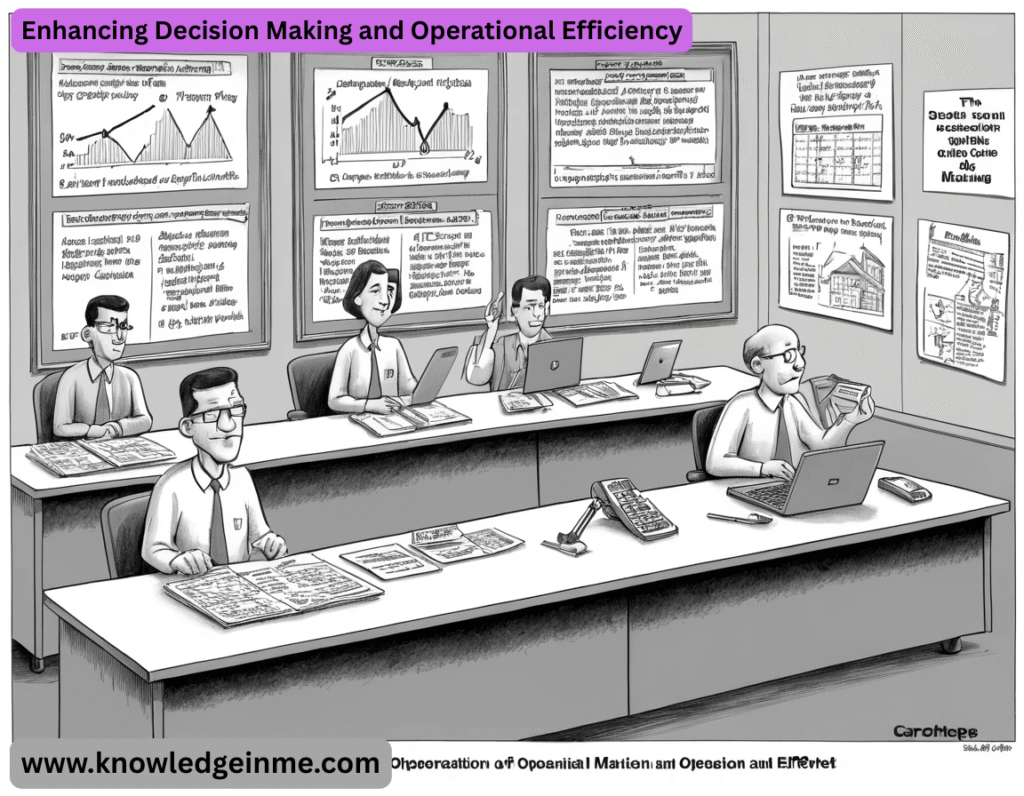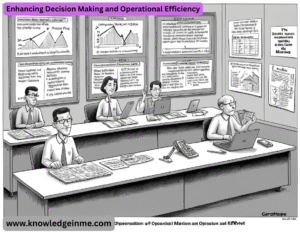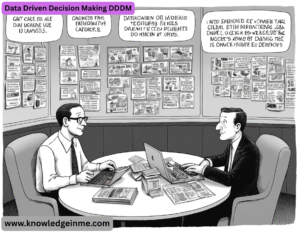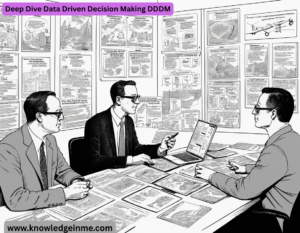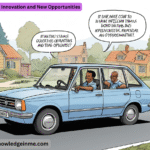Enhancing Decision Making and Operational Efficiency Enhancing decision-making and operational efficiency is crucial for organ izations aiming to improve productivity, reduce costs, and maintain a competitive edge. Here’s a structured approach to achieving these goals:
Data-Driven Decision Making
- Leverage Analytics: Use tools like Power BI, Tableau, or Google Analytics to gather insights from data.
- AI & Machine Learning: Implement predictive analytics to forecast trends and optimize decisions.
- Real-Time Reporting: Ensure decision-makers have access to up-to-date dashboards for agile responses.
Process Optimization
- Process Mapping: Identify bottlenecks using tools like flowcharts or Six Sigma methodologies.
- Automation: Deploy RPA (Robotic Process Automation) or workflow tools (Zapier, UiPath) to eliminate repetitive tasks.
- Lean Management: Adopt lean principles to minimize waste and maximize value.
Technology Integration
- ERP & CRM Systems: Use integrated platforms (SAP, Salesforce) to streamline operations.
- Cloud Computing: Migrate to cloud-based solutions (AWS, Azure) for scalability and remote access.
- IoT & Smart Devices: Implement IoT for real-time monitoring in manufacturing, logistics, etc.
Employee Empowerment & Collaboration
- Training & Upskilling: Ensure teams are proficient in data literacy and new technologies.
- Collaboration Tools: Use platforms like Slack, Microsoft Teams, or Asana for seamless communication.
- Decent ralized Decision-Making: Empower frontline employees with authority to make quick decisions.
Performance Monitoring & Continuous Improvement
- KPS & OKRS: Track key metrics (e.g., cycle time, error rates) aligned with business goals.
- Agile & Iterative Approaches: Continuously refine processes based on feedback.
Risk Management & Scenario Planning
- Predictive Risk Modeling: Use AI to anticipate disruptions.
- Contingency Plans: Prepare for supply chain, cyber, or operational risks.
- Stress Testing: Simulate worst-case scenarios to assess resilience.
Customer-Centric Operations
- Customer Data Analysis: Use CRM insights to personalize services.
- Omnichannel Efficiency: Ensure seamless customer experiences across touchpoints.
- Quick Response Systems: Implement chatbots or automated support for faster resolutions.
Implementation Roadmap
- Assess Current State: Audit existing processes and decision-making frameworks.
- Set Clear Objectives: Define measurable goals (e.g., reduce operational costs by 15%).
- Pilot Solutions: Test automation/AI tools in a controlled environment.
- Scale & Optimize: Roll out successful initiatives organization-wide.
- Monitor & Adapt: Continuously refine strategies based on performance data.
Tools to Consider
- Decision Making: Power BI, Tableau, IBM Watson.
- Operational Efficiency: Trello (task management), Zapier (automation), SAP (ERP).
- Collaboration: Slack, Microsoft Teams, Notion.
Data Driven Decision Making DDDM
Why It Matters
- Reduces guesswork and biases.
- Enables proactive rather than reactive strategies.
Key Steps
A. Data Collection & Integration
- Centralize Data: Use data warehouses (Snowflake, Google BigQuery) or lakes (AWS S3, Hadoop).
- IoT & Sensors: Capture real-time operational data (e.g., machine performance in manufacturing).
- Customer Data: CRM systems (Salesforce, HubSpot) track interactions and preferences.
B. Advanced Analytics
- Predictive Analytics (What will happen?) → Machine Learning (Python, TensorFlow).
- Prescriptive Analytics (What should we do?) → Optimization algorithms (IBM Decision Optimization).
C. AI & Automation in Decision-Making
- ChatGPT for Business Intelligence: Natural language queries for quick insights.
- Automated Alerts: Set thresholds (e.g., inventory levels) for real-time notifications.
Example
- Netflix uses predictive analytics to recommend content and optimize server loads.
Process Optimization & Lean Operations
A. Identifying Inefficiencies
- Value Stream Mapping (VSM): Visualize workflows to spot waste.
- Time-Motion Studies: Track employee tasks to eliminate redundancies.
B. Automation & RPA
- Example: Automating invoice processing in accounting.
- Workflow Automation: Tools like Zapier or Make (Integromat) connect apps (e.g., auto-save email attachments to Google Drive).
C. Lean & Six Sigma
- Lean: Focuses on reducing waste (Toyota Production System).
- Six Sigma: DMAIC (Define, Measure, Analyze, Improve, Control) for defect reduction.
Example
- Amazon’s Warehouses use Kiva robots to optimize picking routes, reducing delivery times.
Technology Stack for Efficiency
A. Enterprise Systems
- ERP (SAP, Oracle Netsuite): Integrates finance, HR, supply chain.
- CRM (Salesforce, HubSpot): Manages customer interactions.
- SCM (JDA, Kinaxis): Optimizes supply chain logistics.
B. Cloud & Edge Computing
- AWS/Azure Cloud: Scalable infrastructure.
- Edge AI: Real-time decision-making in IoT devices (e.g., predictive maintenance).
C. Collaboration Tools
- Slack/MS Teams: Internal communication.
- Notion/ClickUp: Project management & documentation.
Empowering Employees for Better Decisions
A. Upskilling & Training
- Data Literacy Programs: Teach employees to interpret dashboards.
- Simulation Training: Use VR/AR for high-risk decision practice (e.g., emergency response).
B. Decentralized Decision-Making
- Agile Teams: Squads make fast decisions without bureaucracy.
- AI-Assisted Decisions: Tools like Gong analyze sales calls to recommend strategies.
Example
- Spotify’s Squad Model: Small autonomous teams drive innovation faster.
Continuous Improvement & Performance Tracking
A. KPIS & OKRS
- Operational KPIS:
- Cycle Time | Error Rate | Cost per Unit | OEE (Overall Equipment Effectiveness).
Strategic OKRs:
- Example: “Reduce customer response time by 30% in Q3.”
B. Feedback Loops
- Employee Feedback: Regular surveys (Officevibe, TINYpulse).
- Customer Feedback: NPS surveys, sentiment analysis (MonkeyLearn).
C. Agile & Iterative Improvements
- Sprint Retrospectives (Scrum): Reflect on what worked/didn’t.
- A/B Testing: Experiment with process changes (e.g., two warehouse layouts).
6. Risk Management & Contingency Planning
A. Predictive Risk Modeling
- AI for Fraud Detection (Darktrace, Splunk).
- Supply Chain Risk: Tools like Resilinc predict disruptions.
B. Scenario Planning
- War Gaming: Simulate market shifts (e.g., competitor price cuts).
- Disaster Recovery: Cloud backups, redundant systems.
Example
- Walmart’s AI Supply Chain: Predicts demand spikes during hurricanes.
Customer-Centric Efficiency
A. Personalization at Scale
- AI Chatbots (Drift, Intercom): Handle 80% of routine queries.
- Dynamic Pricing: Airlines/hotels adjust prices in real-time.
B. Omnichannel Optimiza
- Unified Customer View: Salesforce CDP (Customer Data Platform).
- Self-Service Portals: Reduce support tickets (Zendesk Guide).
Example
- Starbucks’ Mobile App: AI suggests orders based on past behavior.
Deep Dive Data Driven Decision Making DDDM
A. Infrastructure Setup
Collection
- Structured Data: ERP, CRM, POS systems (e.g., SAP, Salesforce).
- Unstructured Data: Social media, emails (use NLP tools like MonkeyLearn).
- IoT Devices: Predictive maintenance sensors (PTC ThingWorx, Siemens MindSphere).
Integration
- ETL Tools: Apache NiFi, Talend, or Informatica to clean and merge datasets.
- Enhancing Decision Making and Operational Efficiency Data Lake/Warehouse: AWS Redshift (cheap), Snowflake (scalable), or Databricks (AI-ready).
Advanced Analytics
- Python/R Libraries:
- Pandas (data wrangling), Scikit-learn (ML), Prophet (forecasting).
- AutoML: DataRobot, H2O.ai for no-code predictive modeling.
Process Optimization: Step-by-Step Execution
A. Value Stream Mapping (VSM)
- Identify Process Steps: E.g., “Order-to-Cash” cycle.
- Measure Metrics: Cycle time, lead time, % value-added work.
- Spot Waste: Overproduction, waiting, transport (use TIMWOODS framework).
Lean Six Sigma in Action
- DMAIC Example: Reducing hospital patient discharge time:
- Define: Discharge takes 4 hours (target: 1 hour).
- Measure: Bottlenecks in pharmacy, paperwork.
- Analyze: Root cause = manual insurance verification.
- Improve: Automate verification with Olive AI.
- Control: Monitor with control charts.
Technology Stack: Tiered Implementation
A. Quick Wins (<1 Month)
- RPA: UiPath for back-office tasks (e.g., data entry).
- Low-Code Apps: Microsoft Power Apps for custom workflows.
B. Mid-Term (3-6 Months)
- ERP Upgrade: Oracle NetSuite for SMEs, SAP S/4HANA for enterprises.
- AI Chatbots: Google Dialogflow + CRM integration.
C. Long-Term (1+ Year)
- Digital Twin: Siemens X celerator for manufacturing simulation.
- Blockchain: IBM Food Trust for supply chain transparency.

